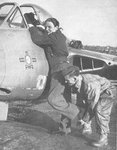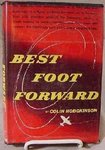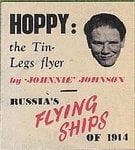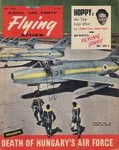lesofprimus
Brigadier General
COLIN "HOPPY" HODGKINSON, who died aged 76, lost both his legs learning to fly, but, inspired by the example of the legless fighter ace Douglas Bader, became an accomplished fighter pilot in the RAF.
Although he called himself "the poor man's Bader" Hodgkinson had no cause to cast himself as an understudy. Such was his courage that he succeeded despite bouts of claustrophobia and an admitted fear of flying and combat.
He also had a horror of being forced to ditch in the Channel and stuffed his hollow legs with ping-pong balls, hoping that they would help to keep him afloat. Once, at 30,000 ft, he took violent evasive action before realising that what he had taken to be a clatter of gunfire was the noise of ping-pong balls exploding at that altitude.
But his self-doubt was masked by the bluff, boisterous bonhomie that characterised not only his wartime career as a fighter pilot but also his postwar success in the competitive world of advertising and public relations.
Hodgkinson was already beginning to be talked about as "a second Bader" when he joined No 611 squadron in June 1943. He flew Spitfires from Coltishall, Norfolk, under Wing-Commander "Laddie" Lucas, the hero of the Battle of Malta.
One August morning Hodgkinson was part of an escort to 36 American B-26 bombers in an attack on Bernay airfield near Evreux, north-west of Paris. The wing was turning for home when more than 50 FW 190s appeared up-sun. The Luftwaffe fighter pilots fell upon the Spitfires.
Lucas turned 611's Spitfires into the attack. There was a furious melee in which the squadron fought all the way back to the coast.
Hodgkinson, remembering his father teaching him to shoot on the family's Somerset estate, shouted: "Swing with it" and. making a well judged beam-into-quarter attack, picked off a 190 and sent it spinning earthwards just as it.was fastening onto Lucas's tail.
Lucas recalled: "It was an uncommonly quick and accurate piece of shooting. Hodgkinson contributed handsomely to a total of five 190s destroyed against two Spit's.
"In 12 rough and eventful minutes Hodgkinson had demonstrated that, despite his massive disability, he could match his skills against the best that General Adolf Galland and his JagdBeschwader 26 had to offer." It was Hodgkinson's second "kill". Earlier he had shot down a FW 190 just off the end of Brighton pier.
Colin Gerald Shaw Hodgkinson was born at Wells, Somerset, on Feb. 11 1920. His father had been awarded the MC and Bar as a Royal Flying Corps pilot in the First World War, and was to serve as an intelligence wing-commander in the Second World War.
Hodgkinson's earliest memories of his father were of a powerful man in hunting pink. As he learned later, he was an outstanding Master of Foxhounds with the Mendip, a big-game hunter and a fine shot. Soon in the saddle himself, the squire's son followed his father's country pursuits until, being judged difficult and unruly, he was condemned to the harsh discipline of a cadetship at the Nautical College, Pangbourne.
In the summer of 1938 Hodgkinson spent an idyllic holiday riding with the French Cavalry School at Saumur, in the Loire, before being accepted for pilot training as a midshipman in the Fleet Air Arm.
After training aboard the aircraft carrier Courageous, he had gone solo and completed 20 hours in a Tiger Moth biplane trainer when he collided with another aircraft.
At the time, acconipanied by his instructor, Hodgkinson was practicing blind flying on instruments with a hood over his head. The Tiger crashed from 800ft at Gravesend, killing the instructor and so grievously injuring Hodgkinson that his legs were amputated. During a long period in hospital he encountered Sir Archibald McIndoe who invited him to his celebrated wartime RAF plastic surgery unit at the Queen Victoria Hospital, East Grinstead, for some work on his face.
Although he was a naval type, Hodgkinson was welcomed into Mclndoe's Guinea Pig Club brotherhood of burned airmen. Such was their spirit that he determined to emulate Bader and to fly again. He set his heart on flying Spitfires and by the autumn of 1942 had wheedled his way out of the Navy and into the RAF as a pilot officer.
He was briefly with No.131, a Spitfire squadron before moving on in the new year, successively to 610 and 510 squadrons. He learned his trade by flying sweeps over occupied France. The following March he was promoted Flying officer and in June joined 611, then in the famous Biggin Hill wing. After his August bomber escort exploit over France, Hodgkinson returned to 501 as a flight commander.
In November, during a high altitude weather reconnaissance his oxygen supply failed, and he crashed into a French field. Badly mangled and minus one of his tin legs he was rescued from the blazing Spitfire by two farm workers. He was reunited with them in 1983, when they presented him with a part of his aircraft's propeller. He had not seen them since being stretchered away en route for a prisoner of war camp via a railway station where his guards abandoned him for some hours in a lavatory while they sheltered from air-raids.
After 10 months Flt-Lt Hodgkinson was repatriated, being deemed of no further use to his country. Yet such was his irrepressible spirit, that after being mended again by McIndoe, he resumed flying, ending the war with a ferry unit at Filton, Bristol. This gave him, as he was to admit, the opportunity of indulging in some pocket-money smuggling, trading such "contraband" as nylons, utility cloth, tea and coffee for cases of brandy among other "imports". Once, he said, he carried gold in his tin legs.
Although he was released from the service in 1946 Hodgkinson returned in 1949 as a weekend flyer. He became a jet pilot and flew Vampires with 501 and 604 squadrons of the Royal Auxiliary Air Force until the early 1950s.
Civilian life presented fresh challenges, and he plunged enthusiastically into the postwar regeneration of advertising and public relations. From the agency Erwin Wasey he moved into PR, learned the ropes and broke away to establish Colin Hodgkinson Associates. With the drive and presson spirit he carried over from fighter days, Hodgkinson prospered, and attracted a mix of prestigious and solid industrial accounts. He also tried politics, standing as a Conservative in the safe Labour seat of South West Islington in the 1955 general election. He made an impressive debut and rediscovered his youthful boxing skills in a punch-up with Labour supporters.
Articulate and a fluent writer, Hodgkinson was briefly air correspondent with the fledgling ITN. In 1957 he published Best Foot Forward, an entertaining account of his life until then.
In 1986 he moved permanently to his holiday home in the Dordogne. He married first June Hunter, a former fashion model. After her death he married Georgina, a Frenchwoman, who survives him.
Acknowledgements to the Daily Telegraph, London.
Although he called himself "the poor man's Bader" Hodgkinson had no cause to cast himself as an understudy. Such was his courage that he succeeded despite bouts of claustrophobia and an admitted fear of flying and combat.
He also had a horror of being forced to ditch in the Channel and stuffed his hollow legs with ping-pong balls, hoping that they would help to keep him afloat. Once, at 30,000 ft, he took violent evasive action before realising that what he had taken to be a clatter of gunfire was the noise of ping-pong balls exploding at that altitude.
But his self-doubt was masked by the bluff, boisterous bonhomie that characterised not only his wartime career as a fighter pilot but also his postwar success in the competitive world of advertising and public relations.
Hodgkinson was already beginning to be talked about as "a second Bader" when he joined No 611 squadron in June 1943. He flew Spitfires from Coltishall, Norfolk, under Wing-Commander "Laddie" Lucas, the hero of the Battle of Malta.
One August morning Hodgkinson was part of an escort to 36 American B-26 bombers in an attack on Bernay airfield near Evreux, north-west of Paris. The wing was turning for home when more than 50 FW 190s appeared up-sun. The Luftwaffe fighter pilots fell upon the Spitfires.
Lucas turned 611's Spitfires into the attack. There was a furious melee in which the squadron fought all the way back to the coast.
Hodgkinson, remembering his father teaching him to shoot on the family's Somerset estate, shouted: "Swing with it" and. making a well judged beam-into-quarter attack, picked off a 190 and sent it spinning earthwards just as it.was fastening onto Lucas's tail.
Lucas recalled: "It was an uncommonly quick and accurate piece of shooting. Hodgkinson contributed handsomely to a total of five 190s destroyed against two Spit's.
"In 12 rough and eventful minutes Hodgkinson had demonstrated that, despite his massive disability, he could match his skills against the best that General Adolf Galland and his JagdBeschwader 26 had to offer." It was Hodgkinson's second "kill". Earlier he had shot down a FW 190 just off the end of Brighton pier.
Colin Gerald Shaw Hodgkinson was born at Wells, Somerset, on Feb. 11 1920. His father had been awarded the MC and Bar as a Royal Flying Corps pilot in the First World War, and was to serve as an intelligence wing-commander in the Second World War.
Hodgkinson's earliest memories of his father were of a powerful man in hunting pink. As he learned later, he was an outstanding Master of Foxhounds with the Mendip, a big-game hunter and a fine shot. Soon in the saddle himself, the squire's son followed his father's country pursuits until, being judged difficult and unruly, he was condemned to the harsh discipline of a cadetship at the Nautical College, Pangbourne.
In the summer of 1938 Hodgkinson spent an idyllic holiday riding with the French Cavalry School at Saumur, in the Loire, before being accepted for pilot training as a midshipman in the Fleet Air Arm.
After training aboard the aircraft carrier Courageous, he had gone solo and completed 20 hours in a Tiger Moth biplane trainer when he collided with another aircraft.
At the time, acconipanied by his instructor, Hodgkinson was practicing blind flying on instruments with a hood over his head. The Tiger crashed from 800ft at Gravesend, killing the instructor and so grievously injuring Hodgkinson that his legs were amputated. During a long period in hospital he encountered Sir Archibald McIndoe who invited him to his celebrated wartime RAF plastic surgery unit at the Queen Victoria Hospital, East Grinstead, for some work on his face.
Although he was a naval type, Hodgkinson was welcomed into Mclndoe's Guinea Pig Club brotherhood of burned airmen. Such was their spirit that he determined to emulate Bader and to fly again. He set his heart on flying Spitfires and by the autumn of 1942 had wheedled his way out of the Navy and into the RAF as a pilot officer.
He was briefly with No.131, a Spitfire squadron before moving on in the new year, successively to 610 and 510 squadrons. He learned his trade by flying sweeps over occupied France. The following March he was promoted Flying officer and in June joined 611, then in the famous Biggin Hill wing. After his August bomber escort exploit over France, Hodgkinson returned to 501 as a flight commander.
In November, during a high altitude weather reconnaissance his oxygen supply failed, and he crashed into a French field. Badly mangled and minus one of his tin legs he was rescued from the blazing Spitfire by two farm workers. He was reunited with them in 1983, when they presented him with a part of his aircraft's propeller. He had not seen them since being stretchered away en route for a prisoner of war camp via a railway station where his guards abandoned him for some hours in a lavatory while they sheltered from air-raids.
After 10 months Flt-Lt Hodgkinson was repatriated, being deemed of no further use to his country. Yet such was his irrepressible spirit, that after being mended again by McIndoe, he resumed flying, ending the war with a ferry unit at Filton, Bristol. This gave him, as he was to admit, the opportunity of indulging in some pocket-money smuggling, trading such "contraband" as nylons, utility cloth, tea and coffee for cases of brandy among other "imports". Once, he said, he carried gold in his tin legs.
Although he was released from the service in 1946 Hodgkinson returned in 1949 as a weekend flyer. He became a jet pilot and flew Vampires with 501 and 604 squadrons of the Royal Auxiliary Air Force until the early 1950s.
Civilian life presented fresh challenges, and he plunged enthusiastically into the postwar regeneration of advertising and public relations. From the agency Erwin Wasey he moved into PR, learned the ropes and broke away to establish Colin Hodgkinson Associates. With the drive and presson spirit he carried over from fighter days, Hodgkinson prospered, and attracted a mix of prestigious and solid industrial accounts. He also tried politics, standing as a Conservative in the safe Labour seat of South West Islington in the 1955 general election. He made an impressive debut and rediscovered his youthful boxing skills in a punch-up with Labour supporters.
Articulate and a fluent writer, Hodgkinson was briefly air correspondent with the fledgling ITN. In 1957 he published Best Foot Forward, an entertaining account of his life until then.
In 1986 he moved permanently to his holiday home in the Dordogne. He married first June Hunter, a former fashion model. After her death he married Georgina, a Frenchwoman, who survives him.
Acknowledgements to the Daily Telegraph, London.




